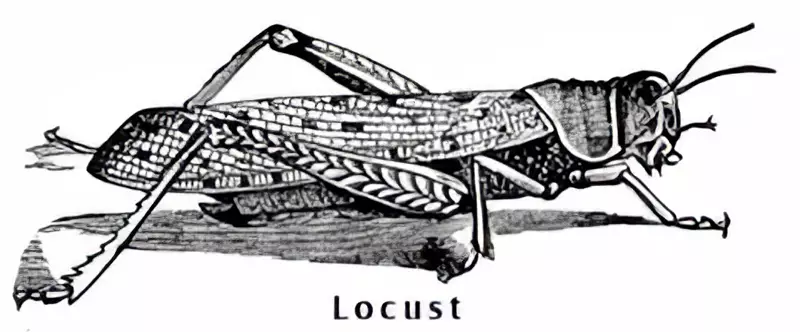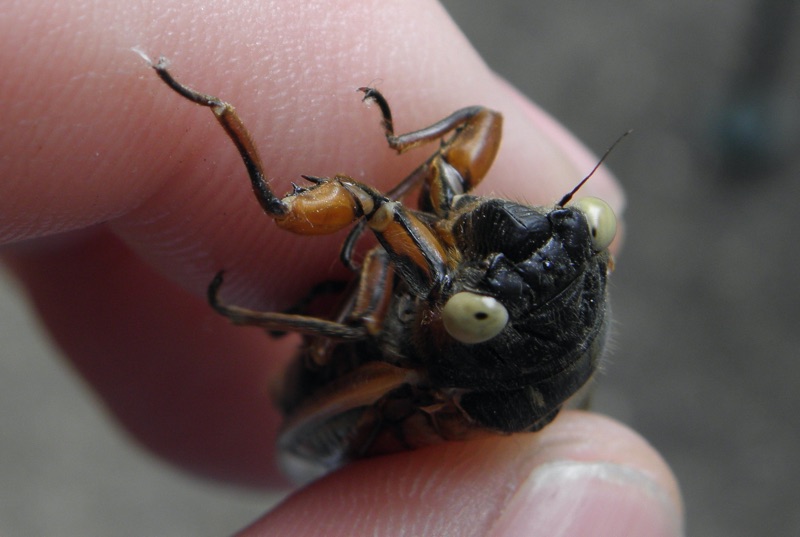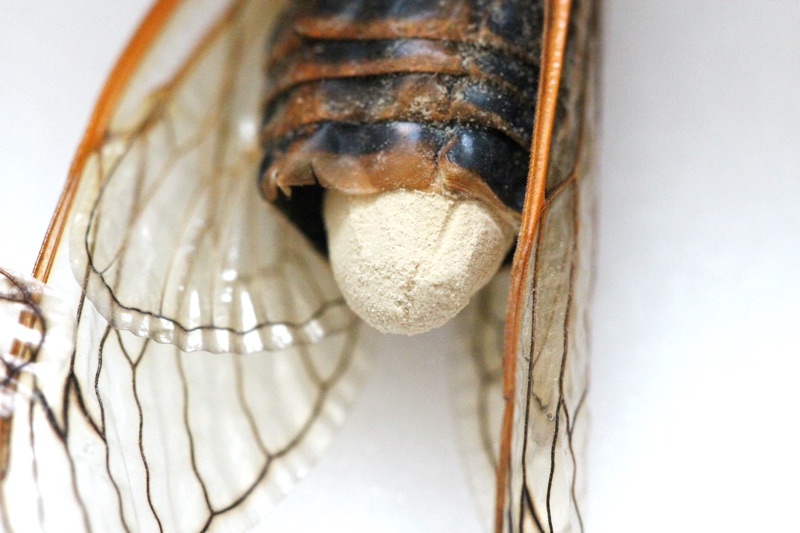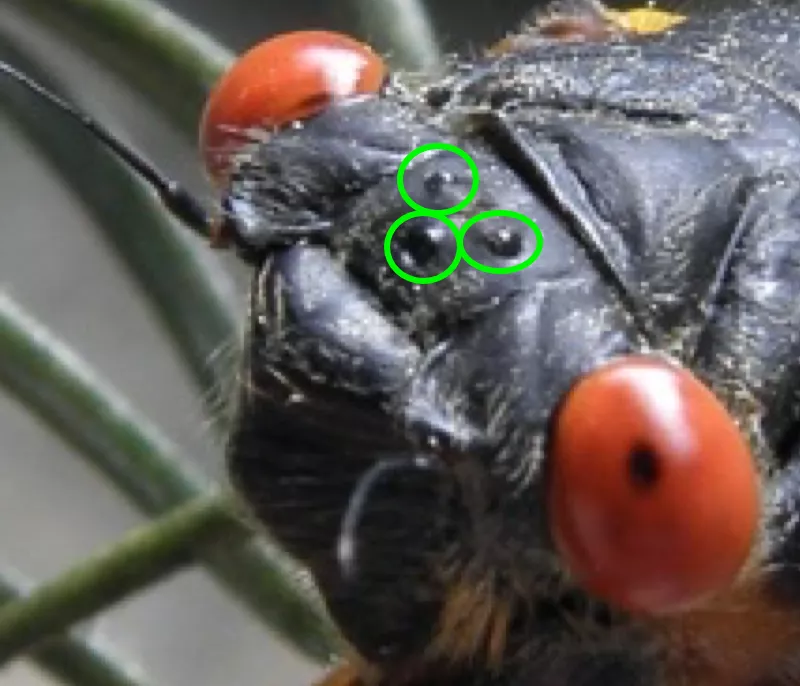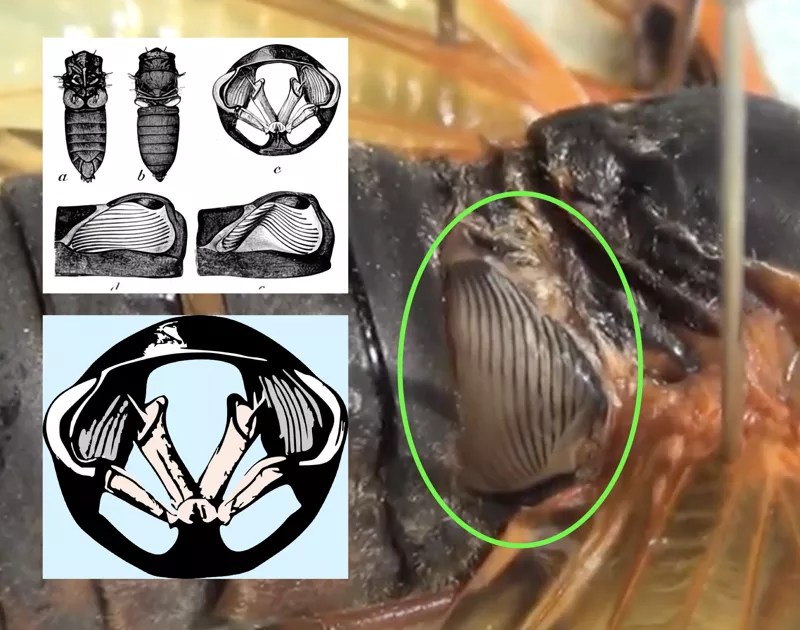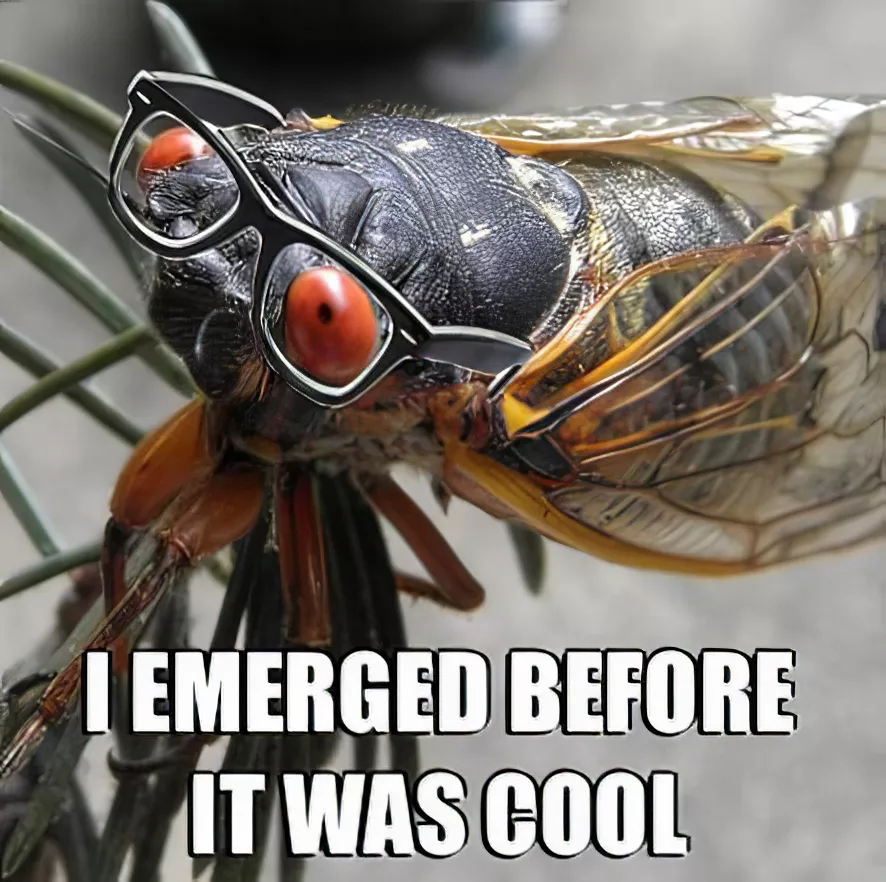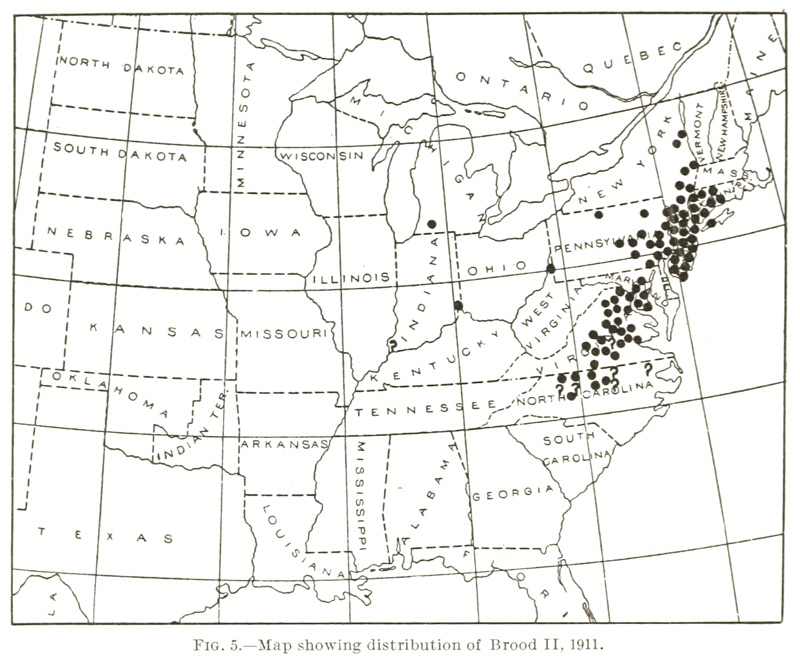Brood XIX (19) periodical cicadas emerged in the spring of 2024 in Alabama, Arkansas, Georgia, Illinois, Indiana, Kentucky, Louisiana, Missouri, Mississippi, North Carolina, Oklahoma, South Carolina, Tennessee, and Virginia. Rotten, but not forgotten, Brood XIX will be back in 2037. Relive the memories: Gene Kritsky released a new book. See what people found iNaturalist: Flagging (Brown Leaves), Brood XIX, Massospora, and Blue and White eyes. Buy a shirt. Yes, Brood XIII also emerged in 2024, but they did not overlap but came close in the Springfield, Illinois area.
What, when, where, and why:
What:
Millions of these cicadas: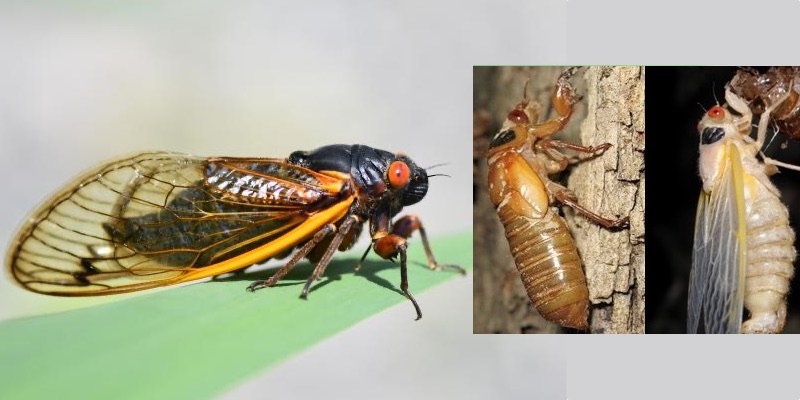
- Cicada insects with a 13-year life cycle.
- Some people call them “locusts” but they are cicadas. (Locusts are grasshoppers.)
- Which species: All four 13-year species:
- Magicicada neotredecim Marshall and Cooley, 2000. Their range includes AR, IL, IN, KY MO, & OK.
- Magicicada tredecim (Walsh and Riley, 1868). Their range includes AL, AR, GA, IL, IN, KY, LA, MD, MO, MS, NC, OK, SC, TN & VA
- Magicicada tredecassini Alexander and Moore, 1962
- Magicicada tredecula Alexander and Moore, 1962
- The last time Brood XIX emerged was in 2011.
- NOT the green cicadas that arrive annually.
Brood XIX has a 13-year cycle. It is interesting because it features both Magicicada neotredecim and Magicicada tredecim. These cicadas are very similar in song and appearance, but in areas where they overlap, Magicicada neotredecim alters its song to a higher pitch, which allows female cicadas to determine the species of their prospective mates. Visit Cicadas @ UCONN for more info on this behavior.
M. tredecim also have more orange on their abdomen than M. neotredecim.
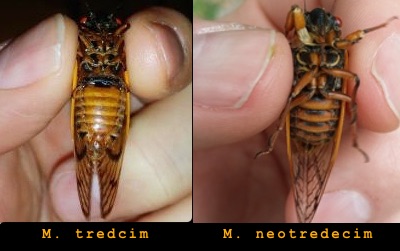
When: Typically beginning in mid-May and ending in late June. These cicadas will begin to emerge approximately when the soil 8 inches beneath the ground reaches 64 degrees Fahrenheit. A nice, warm rain will often trigger an emergence.
Other tips: these cicadas will emerge after the trees have grown leaves, and, by my own observation, around the same time Iris flowers bloom.
Where:
View the live maps on iNaturalist.
- Alabama counties: Barbour, Bullock, Butler, Calhoun, Chambers, Choctaw, Clarke, Colbert, Crenshaw, Elmore, Etowah, Greene, Lawrence, Limestone, Lowndes, Monroe, Montgomery, Russell, Sumter, Tallapoosa, Wilcox
- Alabama cities: Huntsville, Lowndesboro, Talladega
- Arkansas counties: Boone, Futon, Howard, Izard, Lawrence, Marion, Montgomery, Pike, Scott, Searcy, Sevier, Sharp, Washington, Yell
- Georgia counties: Bibb, Bleckley, Butts, Columbia, Elbert, Greene, Harris, Houston, Jasper, McDuffie, Monroe, Muscogee, Newton, Jasper, Oconee, Peach, Pulaski, Putnam, Richmond, Stephens, Taliaferro, Troup, Waren, Wilkes
- Georgia cities: LaGrange, Lincolnton, Rome, Washington.
- Illinois counties: Adams, Brown, Calhoun, Cass, Champaign, Clark, Clay, Coles, Cumberland, De Witt, Effingham, Fayette, Ford, Franklin, Gallatin, Hamilton, Hancock, Iroquois, Jefferson, Johnson, Marion, Massac, Morgan, Moultrie, Pike, Pope, Saline, Shelby, Vermillion, Washington, Williamson
- Illinois cities: Charleston, Decatur, Wamac
- Kentucky counties: Allen, Caldwell, Christian, Trigg
- Louisiana parishes: Caddo, Claiborne, Madison, Morehouse, Ouachita, Washington, Webster. Parish information comes from older literature, and might not be as accurate as recent information.
- Maryland counties: St Marys
- Missouri counties: Adair, Boone, Callaway, Carter, Clark, Cooper, Dent, iron, Jackson, Knox, Louis, Lincoln, Macon, Maries, Marion, Montgomery, Morgan, Oregon, Osage, Pettis, Phelps, Ralls, Reynolds, St. Carles, St Francois, St Louis
- Missouri cities: Columbia, Gerald, Manchester, Pevely, Poplar Bluff, St. Louis, Troy
- Mississippi counties: Kemper, Newton
- North Carolina counties: Buncombe, Cabarrus, Chatham, Davidson, Davie, Durham, Gaston, Guilford, Mecklenburg, Montgomery, Orange, Randolph, Rowan, Stanly, Union, Wake
- North Carolina cities: Apex, Baldwin Township, Chapel Hill, Charlotte, Durham, Harrisburg, Mebane, New Hill, Pittsboro, Raleigh, Waxhaw
- Oklahoma counties: McCurtain
- South Carolina counties: Abbeville, Aiken, Anderson, Cherokee, Chester, Edgefield, Greenwood, Lancaster, Lexington, McCormick, Newberry, Oconee, Saluda, Union, York
- South Carolina cities: Chester, Little Mountain, Rock Hill, Saluda, Tullahoma, Winnsboro
- Tennessee counties: Blount, Cheatham, Clay, Coffee, Davidson, Grundy, Hamilton, Jackson, Loudon, Macon, Marion, McMinn, Meigs, Putnam, Rutherford, Sequatchie, Smith, Stewart, Summer, Williamson
- Tennessee cities: Gallatin, Lebanon, Nashville, Spring Hill
- Virginia counties: Caroline, Glouchester, Halifax, James City, King and Queen, King William, Middlesex, New Kent, York
- Virginia cities: Alexandria, Stafford, Williamsburg
More Location Tips:
- Official iNaturalist Project
- Not sure? Ask someone in your community who lived there 13-years ago.
- Cicadas @ UCONN has the most up-to-date maps to predict where they will show up
- A Tale of Two Broods: The 2024 Emergence of Periodical Cicada Broods XIII and XIX book by Dr. Gene Kritsky.
- The Cicada Safari app for iOS and Android to find and report cicadas.
- The University of Connecticut Periodical Cicadas website.
Why: Why do they stay underground for 13 years? The prevailing research suggests they’ve evolved a long, 13-year lifecycle allowing them to avoid predators that would sync up with their lifecycle & emergence. Why are there so many?! Research suggests that their huge numbers allow them to overwhelm predators, so enough of them will live on to breed and perpetuate the brood.
More facts and fun:
- Use the correct image when talking about these cicadas.
- Use the Periodical Cicada Emergence Checklist for the Maximum Magicicada Experience.
- All cicada questions that are frequently asked.
- A video to help you tell the difference between the species.
- The 17 Most Interesting Periodical Cicada Facts.
1907 Map from Marlatt, C.L.. 1907. The periodical cicada. Washington, D.C.: U.S. Dept. of Agriculture, Bureau of Entomology.
See a modern map or the Live Map from the Cicada Safari app.
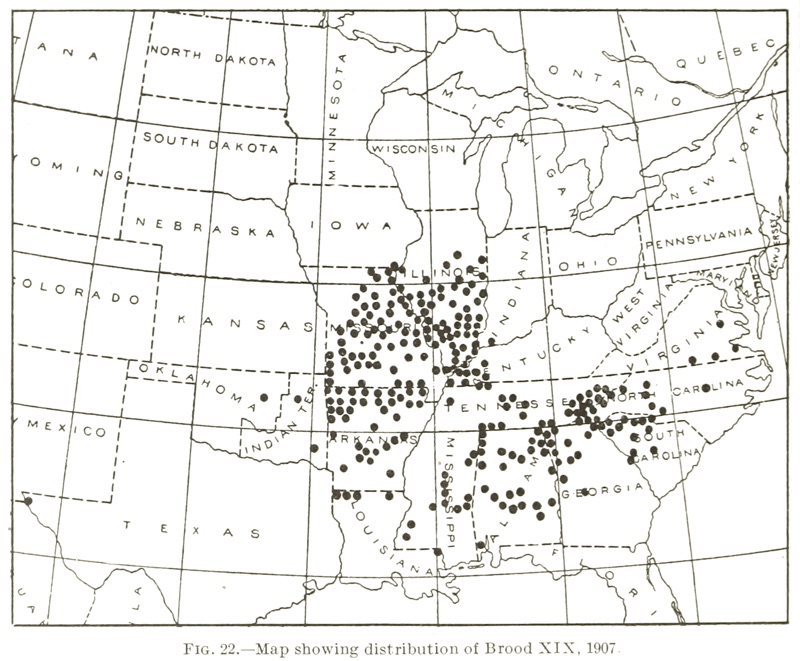
What happened in 2011? Here’s some old blog posts with comments:
- A Brood XIX Periodical Cicada Primer
- The first photographed 2011 13-year cicada
- Periodical cicada fun facts to help you survive a cicada invasion
- Cicada Contest: Find a Cicada with White Eyes and Win a Prize
- Look out for Magicicadas with white eyes
What happened in 1998? Here’s our message board from then:
